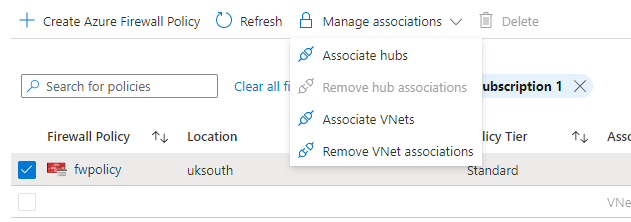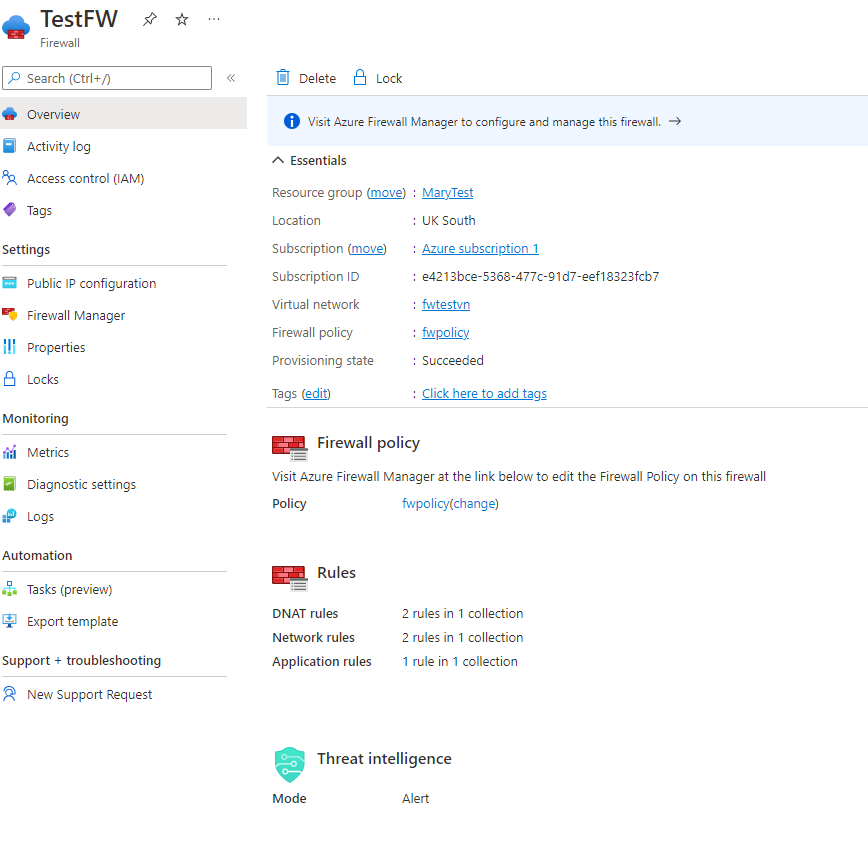This guide goes through the necessary steps for migrating a Firewall with Azure Firewall Classic rules to a Azure Firewall using an Azure Firewall Manager Policy as well as possible use cases for migration.
A company may have resources in Azure that are distributed accross many Azure Virtual Networks. To protect those resources, an Azure Firewall may be deployed in a single instance. Over time the needs of the company may grow, and they may choose to implement additional Firewalls. As the complexity of the networking resources in Azure develop, the company may look for a more simplified way to manage multiple Firewalls, this is where Azure Firewall Manager assists.
Azure Firewall Policies can span multiple Firewall instances in both Secured Virtual Hubs and Hub Virtual Networks, as well as cross region and subscription. This makes it a popular method of deployment for organisations with many Firewalls in different regions.
Azure Firewall Manager is a security management services that provides centralised security policy and route management for cloud-based security perimeters. Firewall Manager can provide security management for two network architecture types, secured virtual hub and hub virtual network.
Azure Firewall Manager centralises the management of Firewalls into a single view and allows organisations to apply a single Firewall Policy to many Firewalls. This allows the configuration updates of Azure Firewalls to span across many Firewall's in different regions and subscriptions as opposed to updating each Firewall individual which can result in a management overhead.
Firewall Policy is a central component of Azure Firewall Manager and can consist of NAT settings, Network rule collections, Application Rule Collections and Threat Intelligence settings.
Once a Firewall policy is created you can apply them to Firewalls across regions, for example you could create a policy in the West US region and use it in East Us. The policies can be associated to one or more virtual networks and virtual hubs.
Azure Firewall supports Standard and Premium Policies. Standard policy provides features such as:
- NAT rule, Network rules, Application Rules.
- Custom DNS, and DNS Proxy
- IP Groups
- Web categories
- Threat Intelligence
Premium Policy features include all of the standard rules, and additionally:
- TLS Inspection
- URL Filtering
- IDPS
Policies are billed on the number of firewall associations with each policy. A policy with zero or one firewall association is free of charge and a policy with multiple firewall associations is billed at a fixed rate of $100 per policy, per region.
How to Migrate a Firewall with Azure Firewall Classic rules to Azure Firewall using Azure Firewall Manager Policy
Using this method can ensure the migration of classic rules to Azure Firewall Policy with zero downtime. It is important to remember that as the policy is being created in advance, any changes made to the policy before being applied to the Firewall will be adhered to once live, so that may cause impact. The operation of switching from classic rules to Firewall policy will not.
Firstly, follow the steps in this guide to migrate an existing Firewall configurations to an Azure Firewall Policy resource using a Powershell Script. https://github.com/MicrosoftDocs/azure-docs/blob/main/articles/firewall-manager/migrate-to-policy.md
After this script has been run you will have an Azure Firewall Policy in the Resource Group you specified. The Firewall Policy will have migrated all of the rules from the classic mode over to the Firewall Policy.
Once this policy has been created you will need to associate the Hubs and Vnets to use Firewall Policy and attach the policy that was created in an earlier step.
To do this go to Firewall Manager > Azure Firewall Policies
Once there, click on the checkbox of the policy that was created in the earlier step and select the manage associations drop down.
Here you will be able to associate your vnets and Hubs from your subscriptions with the Azure Policy.
Once you have associated your Classic Firewall Vnet's with the new policy it will be able to be managed by Azure Firewall Manager and Azure Firewall Policy.


